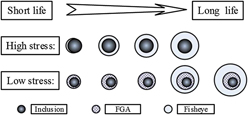Published online by Cambridge University Press: 27 July 2015

The axial loading test was performed to investigate the effect of carburizing on crack initiation and growth behaviors of a gear steel under high cycle fatigue (HCF) and very high cycle fatigue (VHCF). As a result, the carburized gear steel exhibits the duplex S–N characteristics associated with different interior failure mechanisms. The failure process in the HCF regime can be described as inclusion → fisheye → final crack growth zone (FCGZ) → momentary fracture zone (MFZ), whereas that in the VHCF regime is described as inclusion → fine granular area (FGA) → fisheye → FCGZ → MFZ. Based on the definition of crack sizes at different transition stages and the evaluation of stress intensity factor, the models for predicting crack initiation and growth lives in the HCF regime and in the VHCF regime were established. The predicted crack initiation life tends to increase with the decrease of stress amplitude. In the VHCF regime, the crack initiation life associated with the FGA size is almost equivalent to the total fatigue life, whereas the crack growth life only occupies a tiny fraction. In view of the good agreement between the predicted and experimental results, the theoretical modeling method based on crack initiation and growth can be well used to predict the fatigue life of carburized steel with the interior inclusion-induced failure in the HCF regime and in the VHCF regime.